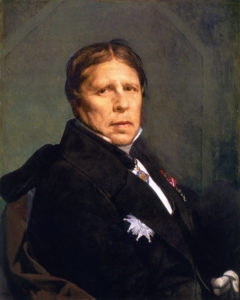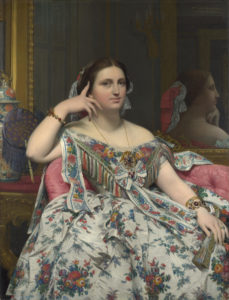Jean-Auguste-Dominique Ingres was one of France’s great nineteenth-century master painters. He is often regarded as a Neoclassicist, but his work often transcended categories and labels. He was a bastion of artistic conservatism, often opposing the passion and sensuality of the Romantic painters. But Ingres may have been shocked to know that his works inspired not just academic painters but the modernists and avant-garde artists of the late nineteenth and twentieth centuries.
After studying under Jacques-Louis David and working as a portraitist in French-controlled Rome, Ingres soon became one of the leading figures in the divide between Neoclassical and Romantic painters. In a real-life personification of this divide, he developed a rivalry with his contemporary Eugène Delacroix. Delacroix’s work is sensual and colorful, while Ingres produced more refined and clean work, keeping within the academic tradition. Some art historians argue that the Neoclassical-Romantic divide continued an artistic divide from over a hundred years earlier. In 1671, an argument broke out among members of the Royal Academy as to what artistic component was the most important in a work: form or color. The Academy divided itself into factions, with the Poussinistes, named after the French Baroque painter Nicolas Poussin, arguing that the form of the subject deserved the most attention (and that color was merely decorative). Meanwhile, the Rubenistes, named after the Flemish master Peter Paul Rubens, prioritized color. They argued that color was paramount because the point of art was to strive towards recreating nature itself. At the same time, the Poussinistes believed that the point of art was to take a subject in one’s mind and recreate its form using nature as a mere reference point. The supposed “resolution” to this argument occurred decades later when the Academy admitted Rococo painters like Antoine Watteau. Despite the matter’s resolution in the early eighteenth century, these same arguments continued into the nineteenth through Ingres and Delacroix. Delacroix once described Ingres’s work as “the complete expression of an incomplete intelligence”. Meanwhile, some report that whenever Delacroix would enter a room, Ingres would mutter, “I smell brimstone.” There are stories that involve the two artists nearly coming to blows and having to be separated. However, similar to the stories about the strained relationships between van Gogh and Gauguin or between Degas and Manet, some of the more sensational stories may contain some exaggeration.
Despite being rooted firmly in traditional artistic styles, Ingres found a way to incorporate abstraction into his academic works so that the subjects could achieve the form he desired. His depiction of the human form often went beyond the classical ideal. His paintings like Jupiter and Thetis and Roger Freeing Angelica show contortion that does not quite fit within the sculpted confines of the Greco-Roman aesthetic. Even in his portraits, Ingres did not always stick to strict realism. For example, his 1856 Portrait of Madame Moitessier may seem inoffensive until you look at the subject’s hands. They seem unnaturally shaped, as if they’re made of rubber, fingers bending this way and that. In this abstraction, Ingres unwittingly exerted a massive amount of influence on later modernists, who would develop styles completely contrary to the academic orthodoxy Ingres stood for. The Impressionists, for example, drew an incredible amount of influence from Ingres’s use of form. They also admired one rather paradoxical aspect of his career: despite being a defender of the academic style, Ingres did not hold the Academy’s Salon in the highest regard. Though he had little respect for the nonconformist Romantics, he still recognized that the academic establishment offered little room for experimentation and artistic independence. These same grievances led a new generation of artists like Manet, Monet, Pissarro, Degas, and Renoir to break from the Academy, form independent salons, and develop their own styles.
Even into the twentieth century, Ingres, the pillar of academic conservatism, influenced abstract painters. The aforementioned Portrait of Madame Moitessier must have made quite the impression when Pablo Picasso first saw it at the Louvre since he decided to use it as a model for his own 1932 portrait Woman with a Book. Some art historians also claim that Ingres’s portrait of Louis-François Bertin partly inspired Picasso’s renowned Gertrude Stein portrait. Furthermore, Ingres’s 1859 Turkish Bath likely influenced the form of Picasso’s Les Demoiselles d’Avignon. This list goes on and on. But there is a touch of irony to Ingres’s legacy. He was one of France’s great nineteenth-century artists. He idolized Jacques-Louis David and the neoclassical style, becoming a pillar of academic painting at a time when Romantic and later modernist styles were taking over. And yet, the very things that set him apart from some other academics were what inspired the impressionists, the cubists, the surrealists, and the other modernists who experimented and pushed art to its limits in the century-and-a-half following his death. Nevermind Delacroix; it was Ingres himself who, through his work, became his own worst enemy.


